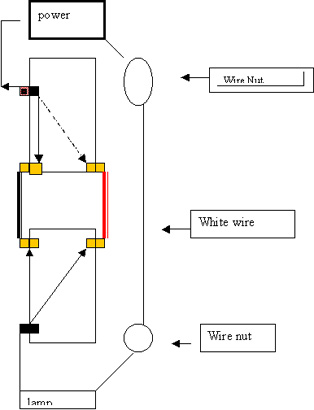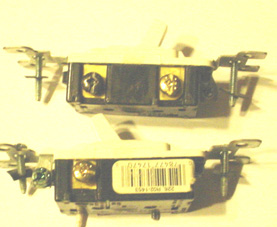A cursory inspection
of a threeway switch will cause you to notice some differences
between this unit and its dipole cousin: 1) the unit is
wider; 2) it has three screws plus ground; 3) two screws at one
end are brass, one screw is different (usually black). 4) the
ON-OFF lever does not say "ON" or "OFF".
The
action of flipping the switch connects the black screw
to one brass screw or to the other. The switches
are used in pairs. The name "three way" comes
from three possible settings: 1) both levers "UP";
2) both levers "DOWN" ; 3) one lever "UP"
the other "DOWN". Three way switches are commonly
used at the top and bottom of a stairway so that the lights
may be turned on or off from either location.
Each
switch has one black screw and two brass screws See figure
below . For each switch we should occupy the black screw
first. At one end, the black from power goes to the black
screw; at the other end, the black from the component (in our
case, a lamp) goes to the black screw. Leave the corresponding
white wires unattended for now.
The
two switches are connected by a special cable known as the "traveler"
that has three conductors: black, red and white (plus ground).
At the switch near the power, connect black wire of the traveler
cable to either brass screw, connect the red wire to the remaining
brass screw, connect traveler white to power white by wire
nut . Connect grounds. Connect wires to screws at
the component end in similar fashion.
|

|

